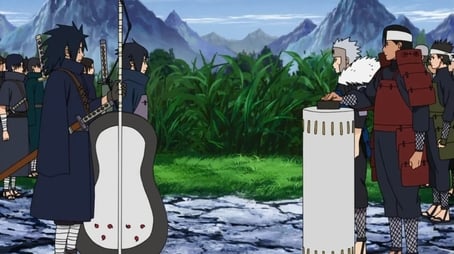Ask Your Own Question
What is the plot?
The episode begins with a flashback to the Warring States period, showcasing the intense battles between the clans. The scene is set in a war-torn landscape, filled with smoke and the sounds of clashing weapons. The focus shifts to a young Shinobi, who is part of the Uchiha clan, as he witnesses the brutal reality of the ongoing conflicts. The emotional weight of loss and the desire for power are palpable as he reflects on the chaos surrounding him.
As the narrative progresses, the scene transitions to the present day, where Naruto Uzumaki, Sakura Haruno, and Sasuke Uchiha are engaged in a fierce battle against the Ten-Tails. The trio is determined to protect their world from the impending doom that the Ten-Tails represents. Naruto, filled with resolve, channels his chakra and prepares to unleash a powerful attack, while Sakura stands ready to support him with her medical ninjutsu.
The battle intensifies as the Ten-Tails retaliates, launching massive energy blasts that threaten to obliterate everything in their path. Sasuke, using his Sharingan, analyzes the creature's movements and coordinates with Naruto and Sakura to dodge the attacks. The teamwork displayed by the trio is crucial as they work in unison, showcasing their growth as ninjas and their deep bond forged through years of friendship and struggle.
In a pivotal moment, Naruto taps into the power of the Sage of Six Paths, enhancing his abilities significantly. He shares this power with Sasuke, who also awakens new abilities, allowing them to confront the Ten-Tails with renewed vigor. The visual spectacle of their combined powers creates a dazzling display of light and energy, symbolizing their determination to overcome the darkness.
As the battle rages on, the episode delves into the backstory of the Uchiha clan, revealing the internal conflicts and the tragic fate of many clan members. The emotional turmoil experienced by the Uchiha, particularly Itachi and Sasuke, is highlighted, showcasing the weight of their decisions and the impact of their legacy on the current conflict. This exploration of their past adds depth to Sasuke's character, illustrating his motivations and the burden he carries.
The climax of the episode occurs when Naruto and Sasuke execute a synchronized attack against the Ten-Tails. Naruto summons a massive Rasenshuriken, while Sasuke channels his Chidori. The two attacks collide with the Ten-Tails, creating a massive explosion that momentarily engulfs the battlefield in light. The sheer force of their combined techniques demonstrates their growth and the strength of their partnership.
In the aftermath of the attack, the Ten-Tails is severely weakened, but the battle is far from over. The episode concludes with a sense of urgency as the characters realize that the true threat is still looming. The emotional stakes are high as Naruto, Sakura, and Sasuke prepare for the next phase of their fight, determined to protect their world and each other from the encroaching darkness. The bonds of friendship and the weight of their past decisions linger in the air, setting the stage for the challenges that lie ahead.
What is the ending?
In the ending of Naruto Shippūden, episode 368 titled "The Era of Warring States," the episode concludes with a flashback to the past, showcasing the tumultuous times of the Warring States period. The episode primarily focuses on the history of the Uchiha clan and the Senju clan, highlighting the deep-seated conflicts and the origins of the animosity between them. The episode ends with a sense of reflection on the cycle of hatred and the hope for a future where peace can be achieved.
As the episode unfolds, it begins with a somber tone, transitioning from the present-day conflict of the Fourth Great Ninja War to the historical backdrop of the Warring States period. The scene opens with a panoramic view of a battlefield, littered with the remnants of war. The air is thick with tension, and the sounds of clashing swords and cries of warriors echo in the distance.
The narrative shifts to the Uchiha clan, where we see a young Madara Uchiha, filled with ambition and a desire for power. He stands alongside his brother, Izuna, as they discuss their clan's strength and the need to protect their legacy. Their bond is palpable, yet it is overshadowed by the looming threat of the Senju clan, led by Hashirama Senju. The rivalry between the two clans is depicted through intense skirmishes, showcasing their unique abilities and the devastating consequences of their battles.
As the story progresses, we witness the tragic fate of Izuna, who falls in battle against the Senju. Madara's grief is profound, and it fuels his desire for vengeance. This pivotal moment marks the beginning of Madara's transformation into a figure consumed by hatred and ambition. The emotional weight of loss is evident as Madara vows to become stronger, seeking to unite the clans through any means necessary.
The episode then transitions to the Senju clan, where Hashirama is portrayed as a compassionate leader, yearning for peace amidst the chaos. He is shown strategizing with his comrades, emphasizing the importance of unity and understanding. Hashirama's internal conflict is highlighted as he grapples with the burden of leadership and the desire to end the cycle of violence. His interactions with his brother, Tobirama, reveal a deep bond, yet also a stark contrast in their ideologies regarding power and peace.
As the narrative unfolds, we see the eventual confrontation between Madara and Hashirama, culminating in an epic battle that symbolizes the clash of their ideals. The animation captures the ferocity of their fight, with stunning visuals of jutsu and the emotional stakes at play. The scene is charged with energy, as both warriors push their limits, embodying the essence of their respective clans.
In the climax of the episode, the battle reaches a turning point, and the consequences of their actions become evident. The cycle of hatred is depicted as a relentless force, perpetuating the conflicts that have plagued the ninja world for generations. The episode concludes with a poignant reminder of the need for understanding and reconciliation, as the characters reflect on their past choices and the impact they have on the future.
As the screen fades to black, the audience is left with a sense of hope intertwined with the weight of history. The episode encapsulates the struggles of the main characters--Madara, Hashirama, and their clans--while emphasizing the overarching theme of the series: the pursuit of peace in a world marred by conflict. The fate of each character is intricately tied to their choices, setting the stage for the ongoing narrative of Naruto Shippūden and the quest for a better future.
Is there a post-credit scene?
In Naruto Shippūden, season 17, episode 368 titled "The Era of Warring States," there is no post-credit scene. The episode concludes without any additional content after the credits roll. The focus remains on the main storyline and character developments throughout the episode, particularly highlighting the historical context of the Warring States period and its impact on the current events of the Fourth Great Ninja War. The narrative centers around the struggles and motivations of the characters as they confront their pasts and the legacies of their ancestors.
What role does Madara Uchiha play in episode 368?
In episode 368, Madara Uchiha is a central figure as he continues to manipulate events during the Fourth Great Ninja War. His overwhelming power and strategic mind are showcased as he battles against the Allied Shinobi Forces. Madara's motivations are driven by his desire to create a world free of conflict, which he believes can only be achieved through his vision of the Infinite Tsukuyomi.
How does Naruto's character develop in this episode?
In this episode, Naruto's character development is highlighted through his determination to protect his friends and the world from the chaos of war. He reflects on the past and the sacrifices made by previous generations of shinobi, which fuels his resolve to become a stronger leader. His emotional state is one of hope mixed with the weight of responsibility, as he grapples with the legacy of the shinobi world.
What is the significance of the flashbacks to the Warring States period?
The flashbacks to the Warring States period serve to provide context for the ongoing conflict in the present. They reveal the origins of the shinobi clans and the struggles they faced, highlighting the cycle of hatred and war that has persisted through generations. This historical perspective deepens the viewer's understanding of the characters' motivations and the consequences of their actions.
How do the characters of Sasuke and Sakura interact in this episode?
In episode 368, Sasuke and Sakura's interaction is marked by tension and unresolved feelings. Sakura expresses her concern for Sasuke's path and the darkness he has embraced, while Sasuke remains distant, focused on his own goals. Their dynamic reflects the complexities of their relationship, as Sakura's unwavering support contrasts with Sasuke's internal struggles and quest for redemption.
What impact does the battle against the Ten-Tails have on the characters?
The battle against the Ten-Tails significantly impacts the characters, pushing them to their limits both physically and emotionally. The overwhelming power of the Ten-Tails forces the Allied Shinobi Forces to unite and strategize, showcasing their growth as a team. Characters like Naruto and Sasuke are particularly affected, as they must confront their own fears and insecurities while fighting for the future of their world.
Is this family friendly?
Naruto Shippūden, including episode 368 titled "The Era of Warring States," contains several themes and scenes that may be considered objectionable or upsetting for children or sensitive viewers. Here are some aspects to be aware of:
-
Violence and Combat: The episode features intense battles and combat scenes, which may include graphic depictions of injuries and fighting. Characters engage in ninja warfare, showcasing various jutsu and techniques that can be visually intense.
-
Death and Loss: There are themes of loss and the impact of war, with characters reflecting on the consequences of conflict. This may evoke feelings of sadness or distress.
-
Emotional Turmoil: Characters experience significant emotional struggles, including feelings of betrayal, anger, and despair. These emotional scenes may be heavy for younger viewers.
-
Dark Themes: The overarching narrative involves themes of war, conflict, and the moral complexities of fighting, which may be difficult for some children to fully understand or process.
-
Mature Concepts: The episode touches on the historical context of the ninja world, including the struggles for power and the impact of war on society, which may be more suitable for older audiences.
Parents and guardians may want to consider these elements when determining if the episode is appropriate for younger viewers.


